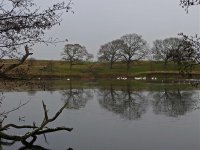I think most (if not all) observers are content that it's not a first generation hybrid, however the question remains as to whether or not it is a backcrossed hybrid (and I'm assuming the Ranworth bird is the same bird as the Cockshoot Broad bird - I think it's been seen with its young hybrid at both sites and they're very close as the duck flies). Personally I couldn't see anything wrong with the belly pattern, though I only got a brief view of that. The head shape did concern me - for most of the time I watched it (especially last winter) it looked worryingly rounded, although every now and then it showed a classic Ferruginous shape. Whether or not its within normal variation for pure Ferruginous Duck I'm not 100% certain - I suspect it may be but then again a second or subsequent generation hybrid would, potentially, be extremely difficult to separate from a pure bird. For me with birds like this, unless it shows features that clearly cannot exist on a pure bird then the common sense approach seems to be to treat it as pure whilst recognising that the possibility of it not being totally pure cannot be eliminated.
I suspect that most of us don't have all that much experience of female Ferruginous Ducks in their normal range. I wouldn't be surprised if we'd find they were rather more variable than the books and some ID articles would have us believe.
As for the bird's origin, there have been plastic-ringed and/or very tame birds in the Broads in recent years, and as this bird was oversummering last year at least (not sure if it was seen this summer and bred locally or not, but I expect so) there has to be some doubt hanging over it. If it were proved to be a backcrossed hybrid (and backcrossed with Ferruginous Duck) then that would probably damage its credentials. Personally I think that a shadow of doubt hangs over any record of Ferruginous Duck in the UK, but that undoubtedly many of them are wild - it's just impossible to know for any given record. Oversummering doesn't help this one's case but it doesn't prove anything. As you say, the Broads are as good a place as any for wild ones.
Whatever it is and wherever it came from, I couldn't find it at Ranworth yesterday afternoon, nor the Ring-necked Duck. Fantastic numbers of dabbling duck there though (especially Teal), plus 2 Goosander and overhead Bewick's Swans. Don't remember it being that good last time I went there.




